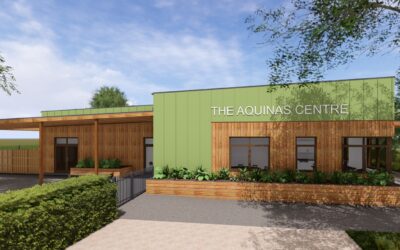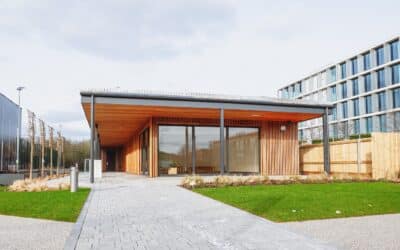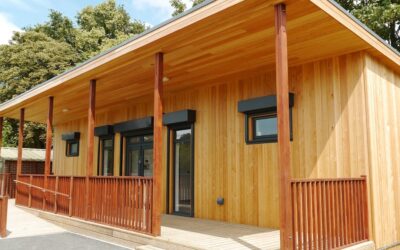TG Escapes Blog
Integrating SEND and Mainstream Students With Thoughtful Building Design
While some children with complex needs benefit most from education within a specialist school, many SEND students can and do thrive in mainstream settings, allowing them to develop alongside their peers.
As the number of SEND students grows, there is increasing pressure on mainstream schools to expand their provisions with specialist units, trained staff, and the physical infrastructure to support all learners.
While much of the work of inclusion is driven by excellent teachers and support staff, a from-the-ground-up design methodology can provide a great foundation. It’s best to think of this as two strands of design, the design of individual classrooms and the design of school buildings as a whole. In addition, our team has seen first-hand how biophilic design principles can improve student and staff experience across schools.
Building Truly Inclusive Classrooms
Classroom design plays a critical role in creating spaces that offer comfortable, productive learning experiences for all students. Adaptable layouts, sensory elements, and exterior access should be prioritised from the initial design process to ensure this.
-
- Flexible Learning Spaces: SEND students can have radically differing needs in terms of space and classroom sizes. Adaptable room layouts can help to account for this, with moveable partitions allowing spaces to be expanded or shrunk as needed. This flexibility promotes joint activities and group work, ensuring that each child can thrive in the same space.
- Breakout Rooms: SEND classrooms benefit from breakout rooms, allowing for simple interventions with students or a quiet space for those with sensory difficulties. Having these rooms directly accessed from the classroom ensures learning isn’t disrupted.
- Sensory Elements: Classrooms designed around SEND and mainstream pupils must take into account the potential sensory difficulties of SEND students. This can include noise sensitivity, combatted through high acoustic insulation levels, and light sensitivity, combatted through dimmer switches.
- Physical Access: SEND classrooms should take into account the access of non-ambulant pupils, with wider doors for wheelchair access, and track hoists within classrooms, the latter of which requires strength reinforcement.
- Seamless Outdoor Access: Easy access to outdoor areas from classrooms provides all students with the many benefits of being outdoors. This is a crucial aspect of Biophilic design, which we’ll discuss more later.
Whether looking to design spaces suitable for all students, or incorporate a specialist SEND area within a mainstream school, it’s crucial to design each room around the physical and mental needs of SEND students. Learn more in our blog “The Design Essentials of a Modern SEND Classroom”.
Bringing Students Together With Integrated Building Design

Using accessible entrances throughout allows all students to navigate the building together
Creating a school where SEND pupils are truly integrated goes beyond classroom design, requiring a thoughtfully structured site that supports all students throughout. From accessible navigation to carefully designed communal spaces, building design can create a school that offers the best possible experience for each pupil.
-
- Accessible Entrances and Corridors: Wide corridors, ramps, and easy-to-navigate spaces are essential for a fully inclusive school. Accessible pathways allow students with mobility challenges to move comfortably around the building and grounds, ensuring that all students can participate fully in school life without feeling isolated or restricted.
- Designing Around Social Interaction: Communal areas such as dining halls, libraries, and social areas can be designed to encourage interaction between SEND and mainstream students. Including quiet areas within these areas will also allow those who may need a sensory break to take a moment to recharge, while still remaining within a shared, inclusive setting.
- Acoustics and Lighting for Focus: Managing noise levels and maximising natural light are key to creating a calm, focused environment for all students. Acoustic treatments help reduce noise, which is particularly beneficial for students prone to sensory overload in busy spaces, while ample natural lighting promotes well-being and concentration, enhancing the learning experience for everyone.
- Inclusive Toilets: Accessible toilet facilities are crucial for SEND pupils, and should be incorporated into social areas within the school to ensure that SEND pupils have simple access.
The Amazing Benefits of Biophilia

Biophilia, a design ethos that establishes a connection to nature within buildings, is increasingly used in school design to create calming, inclusive environments for all students. In a biophilic setting, natural light, greenery, and organic materials work together to promote well-being, focus, and collaboration. For students with special educational needs, particularly autism, biophilic elements provide sensory benefits, reducing anxiety and enhancing comfort. There are a few ways to incorporate biophilic design into a school building.
Biophilic design can impact both building and classroom design. Natural materials should be prioritised throughout, such as the timber our team uses in our school buildings. Classrooms and other spaces should be designed around natural light, access to the outdoors, and excellent levels of ventilation. This approach will create calm, positive spaces for all students, and can even improve exam results.
How Modular Construction Helps to Create Inclusive Spaces
Modular construction is uniquely suited to creating inclusive school environments, combining flexibility, speed, and affordability. Unlike traditional construction, modular buildings are designed and built offsite in controlled environments, reducing on-site disruption and allowing schools to operate smoothly during installation. This is especially important for SEND students who may be more sensitive to environmental changes and noise.
The buildings themselves can be tailored to include flexible learning spaces, sensory zones, and seamless access to outdoor areas, helping to foster integration between SEND and mainstream students. Accessibility features like wide corridors, ramps, and accessible toilets can also be included.
A modular solution, such as the panelised system our team uses, allows for complete customization in advance, with every aspect of the building and outside space tailored around creating a fantastic learning environment.
Our Award-Winning SEND Buildings
TG Escapes create bespoke, inclusive SEND environments for schools across the UK. These spaces blend seamlessly with existing facilities while fostering inclusive learning. Here are just a few of our standout projects.
- SEND Hub for the Visually Impaired at Woking High School: Our team collaborated with Surrey County Council to design and construct a specialised SEND hub for visually impaired students at Woking High School. The hub includes classrooms, breakout spaces, offices, and additional teaching areas for mainstream use. By carefully addressing the site’s challenging topography, we created an ideal learning environment that supports inclusion and accessibility for visually impaired students.
- SEND Classroom Block at Hundred of Hoo Academy: Working with Barker Associates, we developed a two-storey teaching block for SEND students at the Hundred of Hoo Academy. The design incorporated timber and brick cladding to harmonise with the existing school structures, featuring classrooms, quiet rooms, and office spaces.
- DfE Compliant Inclusive Learning Hub Concept: In response to the nationwide need for SEND spaces, our team has designed an Inclusive Learning Hub concept in partnership with SEND specialists. These hubs, available as 16 or 32-place configurations, integrate seamlessly with mainstream schools, featuring therapy, sensory, and outdoor areas. This ready-to-implement design provides a quick, effective solution for expanding specialist provision, fostering an inclusive environment that supports all students.
Working With TG Escapes
TG Escapes creates inclusive, sustainable learning environments tailored to meet the unique needs of SEND and mainstream students alike. Our expert team delivers seamless, turnkey solutions that prioritise comfort, accessibility, and biophilic design. Discover how we can support your school’s vision for inclusive education today.
About the author
More posts from our blog
Education Estates 2025: Surrey County Council Share Their SEND Provision Strategy, Including the Contribution Made by TG Escapes
At the recent Education Estates 2025 conference, I was proud to join Euan Leslie, Programme Manager for our partners Surrey County Council as we presented their ambitious and highly successful strategy for expanding Special Educational Needs and Disabilities (SEND)...
The Benefits of Choosing a Modular Clubhouse Building
A clubhouse needs to serve many functions, from creating social spaces and meeting areas to offering changing rooms and toilet facilities for players. Modular buildings are an ideal solution for creating flexible, purpose-built facilities for sports teams,...
Supporting Active School Life With Modular Sports Pavilions
Physical activity is a crucial part of everyday schooling across the UK. But in many settings, ageing facilities and limited space can prevent pupils from getting the full benefit of PE, sport, and outdoor recreation. Modern sports and leisure pavilions offer an...





